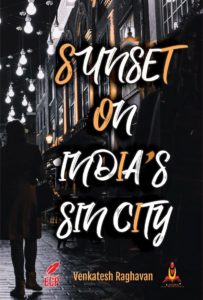
Book Review: Sunset on India’s Sin City

Author: Venkatesh Raghavan
Print length: 148 pages
Language: English
Publisher: BLACKSPINE PUBLISHING PVT LTD
Publication date: 1 June 2021
For seven decades post Independence, Mumbai continued to be famed as India’s sin city with ballroom dancing and strip tease bars being replaced by dance bars gyrating to Bollywood numbers, and service ladies night joints. The sprawling red light area around Kamatipura still continues to stay the attraction albeit on a lesser scale.

Sunset on India’s Sin City is the story of crime fiction writer and www.globalbihari.com consulting editor Venkatesh Raghavan’s interesting encounters picks up thread from the late eighties when the famed sin city enjoyed the reputation for night long food, liquor and sleaze joints, courtesy a Nelson’s eye from the men in uniform in exchange for monetary considerations. It’s a semi-biographical account of his odyssey on Mumbai’s nightlife and entertainment avenues besides indulgences in non-sleaze vices. Though it does not altogether patronize hedonism, it does lend an insight into how Bombay played host to a variety of vices, across strata of society, belonging to both categories, namely tourists and locals.
Popularly called Venky in his immediate circles, the author, who had his previous book launch, Operation Drug Mafia, from the same publishing stables, has made use of knowledge gathered from first hand visits to vice dens and also the study he undertook on the subject by virtue of being a crime reporter. The stories crisscross the paths of both the high and low in the world of sleaze, entertainment and social interactions besides shedding light on how the changing cityscape has affected young lives in their formative years, denying them adequate access to recreation.
Though it might serve to offer voyeuristic pleasure in some parts of the narrative, it does give the reader a feel of “been there and done it.” To be fair to the author, Sun Set On India’s Sin City is an attempt to capture the different moods and phases of how night life, sleaze, and other entertainment avenues underwent transformation in Mumbai once famed as Bombay. The author does offer multiple perspectives when addressing issues like the state government’s protracted court battle against dance bars being operative in the state.
The book highlights how people from different walks have their take on the issue. While people bemoaning the youth recklessly ruining their lives expressed relief on the state government initiative, others were of the opinion that adult youth should be mature enough to understand things and conduct themselves responsibly.
The narrative first throws light on the dance bar issue from the point of view of people wearing the shoes, meaning the dancers whose life was drastically affected by the state government’s positioning. It also offers a window on what horrors the affected people dealt with through the lens of a personal narrative. Many a time, as the reader tends to get absorbed in the dilemmas faced by sleaze joints on advent of the Covid-19 pandemic, it’s felt that the author could have researched more to provide related statistical data to throw light on the dimensions of change in both demographics and financial aspects that need to be dealt with in studying this problem.
The author has by far relied on examples, anecdotes and views from people who directly operate the various vice and entertainment avenues in the city. He has also done sufficient justice in the study of patterns on the various indulgences that kept emerging and vanishing through the decades, finally culminating to a standstill in the post-Covid19 phases.
Venkatesh, who happens to be a dab hand in the exploration of Bombay night life and has spent over three decades doing investigative stories, says he chose this topic to highlight what people from different walks get faced with as sin City looks to be fading. The author’s level of awareness on the topic comes in handy, especially on how the city’s social and recreational life took different turns with the increased usage of social media and Android mobile platforms. One common thread the author has stressed on, when it comes to narrating the changes that have taken place is “follow the money”. On the whole, it’s a good job sans any preachy verbiage.
– global bihari bureau





